
Threat Actors Can Weaponize MCP Servers To Harvests Sensitive Data
The rapid integration of AI assistants and development tools has undeniably revolutionized how we interact with technology. Beneath the surface of enhanced productivity, however, new vulnerabilities emerge. A recent and concerning development highlights how threat actors are exploiting the Model Context Protocol (MCP) servers, turning them into potent weapons for data harvesting. This isn’t just about a potential vulnerability; it’s a novel supply chain attack vector with significant implications for organizations relying on AI-driven workflows.
Understanding the Model Context Protocol (MCP)
The Model Context Protocol (MCP) was designed as a universal “plug-in bus” to streamline the integration of AI assistants. Essentially, it allows these AI tools and development environments to translate natural-language requests into executable commands. Think of it as a translator that enables AI to understand what you want and then act on it within your systems. While incredibly convenient for creating fluid, AI-powered interactions, this very flexibility can be weaponized if the underlying MCP servers are not properly secured.
MCP Servers: A New Supply Chain Attack Vector
Threat actors have recently identified and begun exploiting unvetted MCP servers as a novel supply chain attack vector. The core issue lies in the ability of these servers to run arbitrary code. When an AI assistant or development tool interacts with a compromised MCP server, it’s not just requesting information; it’s potentially exposing itself to malicious instructions. This creates a significant risk:
- Data Exfiltration: Malicious MCP servers can be commanded to exfiltrate sensitive data, including proprietary code, intellectual property, customer information, or other confidential records.
- Command Execution: Arbitrary command execution means threat actors could potentially gain a foothold within an organization’s network, deploy further malware, or disrupt critical operations.
- Privilege Escalation: By leveraging the trust placed in AI integration points, attackers might escalate privileges within the compromised environment.
This exploitation demonstrates a sophisticated understanding of modern IT infrastructure, targeting the connective tissue between AI and operational systems. Organizations must recognize that their AI integration points are now potential entry points for adversaries.
The Mechanics of Weaponization
The process of weaponizing MCP servers typically involves threat actors:
- Identifying Vulnerable Servers: Attackers scan for publicly accessible or easily compromised MCP servers that lack proper authentication, authorization, or secure configurations.
- Injecting Malicious Payloads: Once access is gained, malicious code is injected into the server’s operational logic or through specific API calls.
- Harvesting Data: When legitimate AI assistants or development tools connect to the compromised MCP server, the embedded malicious code executes, allowing the threat actor to harvest data during what appears to be normal operations. This could involve intercepting requests, logging outputs, or initiating data transfers to external command-and-control servers.
Given the nature of AI assistants processing diverse and often sensitive data from users’ queries, the potential for significant data loss or compromise is substantial.
Remediation Actions for MCP Server Security
Securing your MCP server landscape is paramount to mitigating this emerging threat. Organizations should implement the following remediation actions:
- Strict Access Control: Implement robust authentication and authorization mechanisms for all MCP servers. Apply the principle of least privilege, ensuring only necessary entities have access.
- Regular Security Audits: Conduct frequent security audits and penetration testing specifically targeting MCP server configurations and associated AI integration points.
- Network Segmentation: Isolate MCP servers on segmented network zones to limit lateral movement in case of compromise.
- Input Validation and Sanitization: Ensure all inputs processed by MCP servers, especially those originating from AI assistant requests, are rigorously validated and sanitized to prevent command injection and other forms of data manipulation.
- Monitor for Anomalies: Implement continuous monitoring for unusual activity on MCP servers, such as unexpected outbound connections, high data transfer volumes, or unauthorized command executions.
- Supply Chain Verification: When integrating third-party AI tools or MCP servers, thoroughly vet their security posture and ensure they adhere to secure development practices.
- Patch Management: Keep all underlying operating systems, frameworks, and MCP server software up-to-date with the latest security patches to address known vulnerabilities.
- Incident Response Plan: Develop and regularly test an incident response plan specifically tailored to address breaches involving AI integration points and supply chain attacks.
Detection and Mitigation Tools
Effectively addressing MCP server vulnerabilities requires a combination of robust security practices and specialized tools. The table below lists relevant tools that can aid in detection, scanning, and mitigation:
| Tool Name | Purpose | Link |
|---|---|---|
| OWASP ZAP | Web application security scanner, useful for identifying vulnerabilities in web-facing MCP interfaces. | https://www.zaproxy.org/ |
| Nessus | Vulnerability scanner for network devices and servers, can detect misconfigurations and unpatched software. | https://www.tenable.com/products/nessus |
| Snort | Network Intrusion Detection System (NIDS), for real-time traffic analysis and anomaly detection. | https://www.snort.org/ |
| Wazuh | XDR platform with SIEM, EDR, and FIM capabilities, useful for monitoring server logs and filesystem integrity. | https://wazuh.com/ |
| Prisma Cloud (Palo Alto) | Cloud-native security platform, offering comprehensive protection for cloud infrastructure where MCP servers may reside. | https://www.paloaltonetworks.com/cloud-security |
Conclusion
The exploitation of Model Context Protocol (MCP) servers represents a significant evolution in supply chain attacks, underscoring the critical need for organizations to secure every component of their AI integration ecosystem. The convenience offered by advanced AI tools must be balanced with a rigorous security posture. By implementing strong access controls, conducting regular security audits, and leveraging appropriate detection and mitigation tools, organizations can protect their sensitive data from this sophisticated and emerging threat vector. Proactive defense and a deep understanding of how AI components interact with your broader infrastructure are no longer optional but essential for modern cybersecurity resilience.





